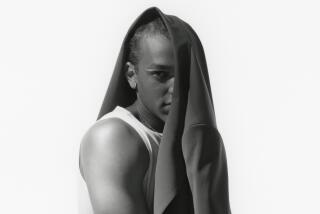TUX, FIT TO A ‘T’
- Share via
There comes a time in every man’s life when he’s faced with two choices: rent or own. This applies to cars, homes and, as the New Year’s Eve formal-party season nears, the tuxedo.
Every grown man should have a tuxedo in his wardrobe, and if you’re plunking down hard-earned greenbacks for a black-tie outfit, why not get something as comfortable as a pair of pajamas that makes you look as dashing as James Bond?
And at a starting price of about $1,600, a made-to-order tuxedo is still probably cheaper than the dress your date may never wear again.
Maybe it’s all those niggling questions about cuffs, colors, vents and rises that make the process sound as daunting as building a suspension bridge. To help steer you straight, we caught up with Brooks Brothers master tailor Martin Greenfield during his recent visit to the Beverly Hills flagship store.
The well-dressed 79-year-old has personally made thousands of tuxedos over his 60-year career, and his clients (through Brooks Brothers as well as private label and under his own name) include President Clinton, Patrick Ewing, Hugh Jackman (pictured), Stephen Colbert and former Secretary of State Colin L. Powell.
Greenfield insists that the customer buying a made-to-order tuxedo can ask for anything, but when pressed, he offered suggestions to help first-time tux buyers make the leap.
--
Let’s start with the basics. Why buy a tuxedo at all?
Rentals are expensive, and if you go to three or four formal events a year, it’s cheaper to buy. Stock tuxedos are made to fit the average body, not yours. And all the dry cleaning you need to do takes the finish off the fabric.
--
How does the tuxedo-buying process work?
First, find a tailor. He -- or the people who work for him -- will ask the right questions. The first thing I like to ask is, what does this person do? Are they a conductor? Are they going to be dancing?
Even though most people will only be wearing a tuxedo for four or five hours, it needs to be functional. If it isn’t cut right, a conductor’s jacket will fly up behind him while he’s conducting.
--
Is there a standard-issue list of requirements, such as the number of buttons, kind of lapel, etc.?
A good tailor will give you whatever you want, but also recommend what might work best for you. First of all, it has got to be wool -- people like me don’t make polyester tuxedos. The better quality wool, the higher the number. Brooks’ Golden Fleece is 120 to 185 microns. There are some new technologies that add just a little bit of stretch too.
Then I usually suggest a jacket with no vents in the back, because you probably won’t be going horseback riding in it, and it creates a more simple line.
For a comedian’s tuxedo jacket, I make a double vent because they’re always putting their hands in their pockets on stage.
--
What about color?
If you have only one tuxedo, it should be black. Some people, like here in Hollywood, have lots of occasions to dress up and wear tuxedos, so they might want more colors. I’ve made them in midnight blue and shadow stripes.
--
What about the lapel?
A notch lapel keeps it looking simple. But for some people, a peak lapel helps them stand out. And there’s also a shawl collar that can be wider or narrower depending on the fashion of the day. It’s all about choice.
--
What are some other choices?
Satin or grosgrain fabric on the lapels, which should match the stripe down the pants. Satin is more traditional. And you can choose pocket flaps or not. I don’t suggest them.
Jackets should show just a little more shirt cuff than a regular suit because you’re wearing French cuffs and cuff links. And people sometimes choose different color linings. Purple is popular now for some reason.
--
What about a cummerbund?
With every tuxedo I make, I suggest adding a strip of fabric above the waistband of the pants to eliminate the need for a cummerbund. It’s one less thing to worry about.
--
One, two or three buttons on the jacket?
I usually go with one button, but it’s just as important to talk about where that button should go: If you like to wear a long tie instead of a traditional bow tie, or wear beautiful shirts with pleats, you may want to put the button lower to show off those things better.
--
Is there a common mistake men make when dressing formally?
You should never wear a tuxedo without formal shoes. Velvet slippers or patent leather are OK -- but they cannot be street shoes. And lots of men wear the necks of their shirts too tight so their necks bulge over.
--
Speaking of shoes, do I need to take them with me when I go to order a tux?
Hopefully you will make at least two visits to your tailor -- the first time, you get all your measurements, choose your fabric and all the options. The second time you will wear shoes and the pants will be hemmed. If you decide to go from a slipper to a shoe, it’s not a problem with a tuxedo because there is no belt or belt loops. Tuxedo pants are traditionally held up with braces or suspenders, which are easily adjusted.
--
Once a tuxedo is ordered, how long will it take?
Usually six to eight weeks.
--
How does a new tux owner care for his investment?
Spot clean any stains and hang it up. Don’t dry clean it; it’s bad for the fabric.
--
What if I, I mean someone, gains or loses weight?
Everything we make custom has enough fabric to go 2 inches bigger -- that’s about 12 pounds of weight gain. Every two or three years you should take your tuxedo in to your tailor and have them refresh it and make it like new again. Like tuning up your car.
--







